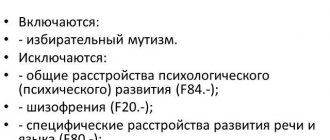- Gallery
- Reviews
- Articles
- Licenses
- Vacancies
- Insurance partners
- Partners
- Controlling organizations
- Schedule for receiving citizens for personal requests
- Online consultation with a doctor
- Documentation
Stuttering (logoneurosis) is a complex speech disorder associated with psychophysiology, in which the integrity and fluency of a person’s speech is disrupted. This manifests itself in the form of repetition or prolongation of sounds, syllables, or words. It can manifest itself in the form of frequent stops or hesitation in speech, as a result of which its rhythmic flow is disrupted.
Speech is one of the most difficult activities. Speech interaction is a necessary condition of life. The development of brain systems that provide speech function does not end in the prenatal period, but continues after birth. The speech function, ontogenetically the most differentiated and late maturing, is fragile and vulnerable - the place of least resistance. And as you know, where it’s thin, it breaks.
Logoneurosis - speech neurosis - a variant of systemic neurosis. Inconsistency between the speech control system and speech reproduction is manifested by a violation of the fluency of speech. And the greater the fear for the outcome of speech, the more speech is disrupted, since attention is fixed. Logophobia increases the severity of logneurosis and complicates its treatment.
Stuttering most often occurs in children aged 2 to 5 years. Hereditary predisposition plays a major role in the development of stuttering. Speech disorders are diagnosed three times more often in boys than in girls. In preschool age, the skills of correct oral speech are formed.
Causes of stuttering:
- increased tone and periodically occurring convulsive readiness of the motor endings of the speech centers of the brain;
- consequences of acute and chronic stress in childhood;
- genetic predisposition (some types of stuttering are inherited);
- consequences of perinatal damage to the central nervous system;
- tendency to have a convulsive reaction;
- various brain injuries;
- injuries, consequences of infectious and endocrine diseases;
- disruption of normal speech development in children (early speech development and delayed psychomotor development);
- children can imitate a person who stutters, but after a while they will develop a stable defect;
- when trying to retrain left-handedness in childhood;
- lack of affection, love, and understanding in a child.
At the age of three, young children develop the coordination system of speech movements and verbal thinking. Speech at this age is the most vulnerable and vulnerable area. Impaired speech development is due to the fact that young children are very easily overstimulated, some of them have a tendency to convulsiveness. A feature of the neurophysiology of this age is the fact that they do not have strong inhibitory reactions. The risk of developing stuttering in an excitable child is much higher than in a phlegmatic child.
Stuttering in children can occur as a result of strict upbringing and increased demands on the child. Some parents want to raise their children to be geniuses; they force their children to memorize large poems, pronounce and memorize difficult words and syllables, which in turn can cause speech development disorders in the child. Stuttering in children can increase or decrease. Provoking factors for increased stuttering can be overwork, colds, disruption of the daily routine, and punishment. If a small child has the first symptoms of a speech disorder, you should immediately contact a specialist; it will not go away on its own.
Stuttering in children must be cured before school. In order to understand how to get rid of stuttering, parents with children aged 2-5 years turn to a speech therapist.
Speech disorders observed during puberty are one of the manifestations of neurosis. Speech impairments may improve as a person gets older. According to statistics, only one percent of the adult population suffers from stuttering.
How to identify stuttering in children?
Despite the fact that stuttering can manifest itself in different ways, muscle spasms of the speech apparatus always cause characteristic symptoms. The difference in the forms of logoneurosis is based on the specific frequency, localization and duration of speech disorders.
Indicators of stuttering in children are:
- disorder of accuracy, intelligibility and clarity of phrases;
- the absence of particularly difficult words, syllables or sounds in speech;
- spending a lot of effort on speech reproduction (the child’s face may turn red, sweat may appear, etc.);
- the presence of auxiliary movements during conversation (shifting from foot to foot, sniffing, clenching fists, etc.). The lack of qualified assistance can lead to the consolidation of these motorcycle standards and subsequently have an additional negative impact on the child’s psyche;
- fear of speech, irritability, tearfulness and withdrawal;
- passive-aggressive behavior;
- difficulties in performing activities requiring fine motor skills (due to impaired motor coordination);
- enuresis, appetite and sleep disorders, etc.
What to do if a child stutters?
Treatment of stuttering in children is carried out jointly by a psychologist, speech therapist and pediatrician.
The pediatrician’s task is to treat concomitant pathologies, strengthen the body, and prevent colds, especially diseases of the ear and vocal cords. It is necessary to treat chronic diseases and achieve stable, long-term remission. It is important to prescribe physiotherapeutic procedures for the child: swimming pool, massage, electric sleep.
A psychotherapist helps a child cope with his illness , helps him feel comfortable in any situation, helps him not to be afraid of communicating with people, helps the child realize that he is not inferior and is no different from the peers around him. Classes with a psychologist are necessarily held together with parents, who also help the child cope with the disease.
Classes with a speech therapist help the child cope with the disease faster.
Classes with a speech therapist
Classes are conducted according to a certain system, have stages and sequence. First, children learn the correct narrative presentation of a text. They read poems and retell homework. The peculiarity of this story is that the child feels comfortable, he knows that he will not be graded, and no one will laugh at him. Children’s speech during such activities is measured, calm, without changing intonation. When it is possible to achieve the absence of stuttering during a narrative story, the child is asked to bring emotional coloring to the speech: somewhere to raise his voice, somewhere to make an accent, somewhere to make a theatrical pause.
During the classes, various life situations in which a child may find himself are simulated. This helps him cope with his stuttering outside the speech therapist's office.
Be sure to keep your child in a good mood . The child should receive rewards for his achievements. Even if it is just praise, the child should feel the significance of his achievements.
Examples of correct speech should be present in classes. This could be the speech of a speech therapist, the conversation of other children who have already successfully completed the course of treatment.
A very important section in the treatment of children with stuttering is the use of a technique such as speech therapy rhythm . This technique includes exercises for the vocal and facial muscles, outdoor games, exercises and games with singing, and round dances.
It is imperative to give your child homework assignments, since treatment should not be limited only to the speech therapist’s office.
Do not, under any circumstances, raise your voice to your child , this can only worsen the stuttering.
The use of modern speech therapy methods helps the child quickly cope with the disease and lead a full life. It is very important to try to cope with stuttering before the child enters school (and for this you need to contact a speech therapist as early as possible and strictly follow all his instructions), since the school curriculum includes public speaking when answering questions from the teacher, which can become a big problem for child.
Overcoming stuttering becomes more difficult with age due to the strengthening of incorrect speech skills and related disorders. Therefore, the sooner treatment is started, the better the result will be. As a result of treatment, 70% of preschool children completely recover from stuttering ; 30% have residual effects; 20% of schoolchildren are completely cured ; 80% had varying degrees of speech improvement.
Services and prices
Primary appointment (examination, consultation) with a speech therapist
2,100 rub.
Repeated appointment (examination, consultation) with a speech therapist
1,800 rub.
Supplement for conducting a consultation or speech therapy session at home (in addition to the consultation or any speech therapist session)
RUB 4,660
Speech therapy session for children with stuttering
2,500 rub.
What is neurotic stuttering
Neurotic stuttering develops as a result of tonic-clonic and tonic convulsions of the articulatory muscles. A spasm occurs in the muscles that participate in conversation: the tongue, larynx, and soft palate.
The provoking factor is stress and psychological trauma in childhood. It usually occurs at 4–5 years of age, when children begin to actively talk. However, it can develop both at an earlier and at an older age.
The most common causes of neurotic stuttering are the following situations:
- chronic stress - conflict in the family or with peers;
- physical illness and associated complexes;
- lack of mutual understanding with parents, practice of physical punishment on their part;
- acute mental trauma - anger, fear, fear, stress.
Another reason is heredity. From birth, such children have a functional deficiency of the speech apparatus, which ultimately leads to stuttering. Therefore, you must not lose your vigilance: do not allow emotional overstrain or stress. Education and communication should be based on parents’ complete control of their emotions: do not lash out at the baby, do not yell at him or scold him. Try to find compromises and resolve issues with care and love.
In some families, parents tend to speed up the child’s development, including speech. The child is constantly dealt with and has increased demands that do not take into account individual characteristics. They load him with reading, force him to learn complex words and poems. Obviously, this is an unbearable physical and mental load. Sooner or later, this reason leads to a breakdown, hysterics, including speech impairment.
If there is already a person in the family who stutters, the child can imitate him.
How to treat
Treatment is carried out jointly with a psychologist, neurologist and speech therapist.
A mandatory component of therapy is sessions with a speech therapist. The specialist selects an individual stuttering correction scheme. First you need to eliminate the old speech stereotype: fast intermittent speech, repetition of words and syllables. The speech therapist teaches the child to relax in order to develop the skill of fluent speech. In this way, a new speech stereotype is created. In the future, it is reinforced by exercises with repetition of sounds, syllables, words, sentences and the whole text.
If the cause is a chronic traumatic situation, it must be eliminated. A psychologist or psychotherapist works with the child. Psychotherapy sessions, psychocorrection, art therapy, and music therapy are conducted. These methods help to relax and change the little patient’s attitude towards his condition. They are also a preventative against secondary speech disorders.
The speech therapist teaches the child to relax in order to develop the skill of fluent speech.
It is important to motivate the child so that he has a desire to study. This way he will try harder.
When the cause of the neurotic form of stuttering in children is conflicts in the family, family counseling and therapy are indicated for all family members. Relatives need to develop the skill of self-control, because for the child to recover, he needs a favorable and calm home atmosphere. Those around you also need to monitor their speech: it should be clear, calm, and in a friendly tone.
Parents need to understand that treatment is not limited to the speech therapist's office. You also need to work with your child at home. In this case, it is necessary to take into account the emotional state of the baby.
Problems related to neurology are solved with medications: sedatives, nootropics, vitamin complexes. The doctor may prescribe physical therapy, massage, and reflexology.
In difficult cases, hypnotherapy is indicated.
Exercises for neurotic stuttering
The number of classes and their duration depend on the age of the child and the severity of the pathology. Typically the session lasts 15 – 20 minutes.
The complex begins with a warm-up - breathing exercises to increase the volume of exhaled air so that the baby can construct long phrases:
- The baby lies on his back and pretends to be the sea with his stomach - inhales through his nose, inflates his tummy, and exhales through a tube. The exercise must be done three times;
- The child blows on the water in a glass through a straw, depicting a storm, a scuba diver or boiling water;
- Boats made of paper are launched into a basin of water, or any toys can serve as boats. You need to blow on the boats so that they float to the other end of the basin.
Exercises can be supplemented with pronunciation of words or sentences. At the same time, you pronounce the words and ask the baby to do the same. Speak slowly and maintain rhythm.
The next exercise is “echo”. You say the word, the child repeats after you.
Guessing riddles, composing oral stories based on drawings, and learning songs are useful for speech development. By the way, singing allows you to achieve smooth pronunciation. It is recommended to be used in everyday life. For example, some word seems difficult for you to pronounce. Try singing it: singing relieves the spasm and you will notice that you can pronounce the word easily.
Drawing, modeling, weaving, and origami have a positive effect. It is known that fine motor skills are related to speech. Such activities are recommended even for healthy children. And for children with neurotic stuttering, they will help improve coordination and articulation.
Stuttering in a left-handed person
Currently, the number of supporters of the theory has increased that a left-hander who has been retrained to use his right hand in most cases develops logoneurosis. Evidence of this is the many stories told by adults who suffered similar bitter experiences in childhood.
Male, 50 years old. From early childhood, according to his mother, the boy began to be retrained from being left-handed to being right-handed. As a result, from the age of 5 the guy began to stutter. Since then, the defect has not left him, remaining to this day.
An interesting story happened with another man. The beginning is like everyone else’s: in childhood they retrained from the left hand to the right, which led to stuttering. Soon the boy fell ill with polio and his right arm became paralyzed. The patient had to learn to do everything with his left hand. Having mastered the skills of left-handedness, it was discovered that the defect had disappeared.
Confirmation of the connection between retrained left-handedness and logoneurosis is sufficient. But scientists argue about the mechanisms of this connection.
Some argue: the reason is in the work of the hemispheres. The brain is characterized by the phenomenon of laterality. One hemisphere in humans turns out to be dominant. At the base of the brain there is a crossover of nerve pathways, so in a left-handed person the right hemisphere predominates, in a right-handed person the left hemisphere predominates.
When a left-handed person is retrained, the influence of the left hemisphere, which is weak by nature, increases. It turns out that the control of both hemispheres is equalized. This is unnatural and goes against the natural functioning of the brain. As a result, one of the consequences is stuttering.
Another theory takes as its basis the mental stress under which a child falls during retraining. There are known cases where children had their left arm tied to their body to immobilize them. If they tried to free their “favorite” limb, they were shouted at, even beaten.
Left-handers were dressed in special harnesses that limited the movements of the left limb. They glued the notebook to the desk on the right side. They resorted to other tricks. And even though over time the methods of retraining have softened and become more cultural, the tension does not go away.
For an emotional child, increased tension and control are a great test, the outcome of which is neurosis. One of the symptoms of neurosis is stuttering.
In general, it becomes clear that retraining a left-handed person carries certain risks regarding the occurrence of laloneurosis.








